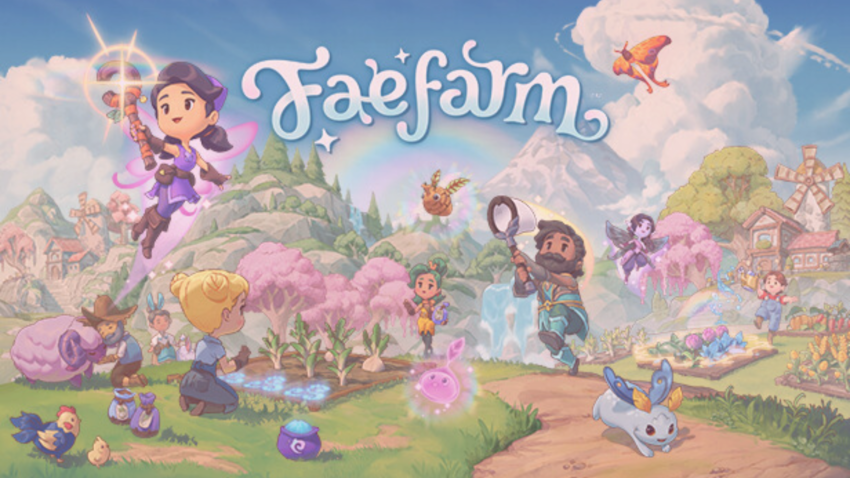Welcome to my Fae Farm review! I did not receive a review code for this title.
Fae Farm is a bright, cartoony 3D farming and life sim made by Pheonix Labs. Pheonix Labs also created the free-to-play, action RPG Dauntless, so I was curious how the huge genre change would work out. They were all over PAX West 2023, including the default lanyards, so I thought I would give it a try on release day.
This review contains minor spoilers. No plot twists will ever be revealed but late game quests might make an appearance by text and screenshot.
As a farming sim addict, I was forced to buy Fae Farm (psychologically speaking) and figured I would give you my honest thoughts as I go.
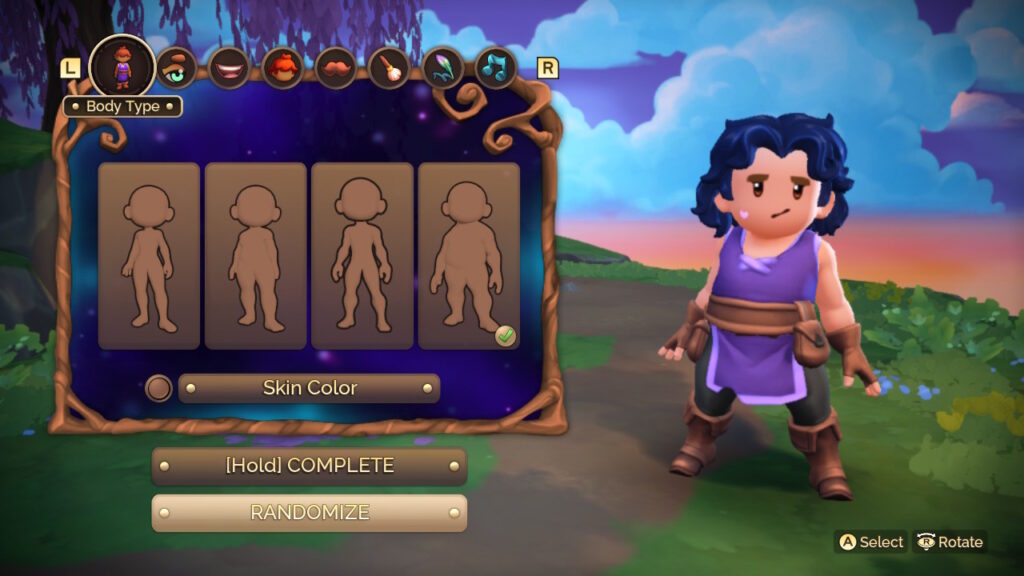
Character Creation
You start by building your avatar, and let me tell you: the mouth is too high on the face. I wish I could have focused on literally anything else but that was the crux of my experience with the character creator.
Typical of a brand new smaller game with likely updates to come, the options are limited when it comes to body shape, hair style, facial hair, and facial details (scars, blush, etc.). The randomizer actually did a pretty decent job of showing me that all hope was not lost. I ended up with a decently cute avatar (seen above).
Oh, and your Fae Farm protagonist’s name is, by default, your Nintendo Switch/Steam account name. And no, you cannot change it. Yuck.
The game will eventually open up and let you buy accessories and clothing to make your character more unique. But a few additional hairstyles right off the bat would have been nice.
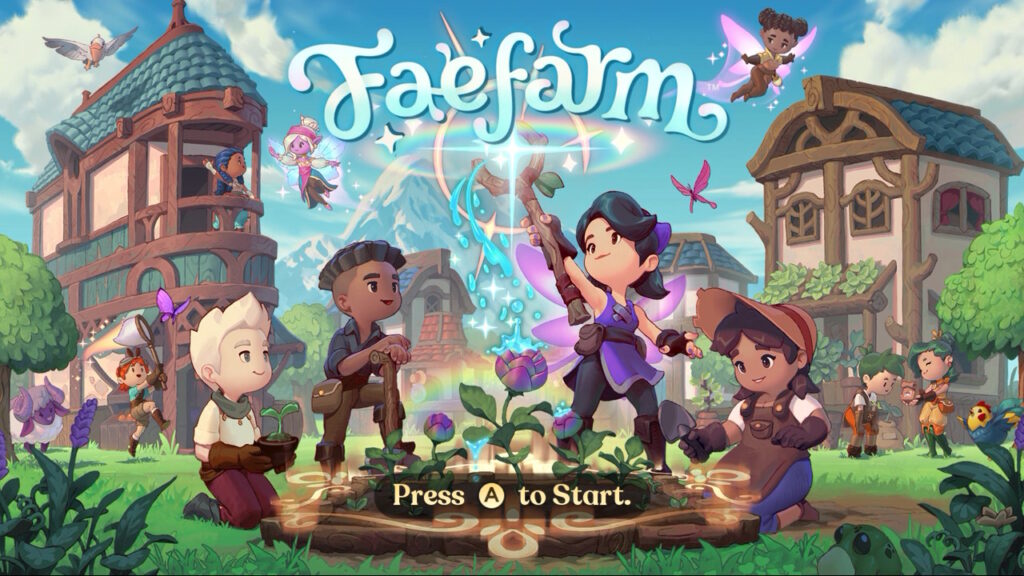
The First Chapter
It opens with a poem telling the tale of you, the character/player, finding a message in a bottle inviting you to another land filled with adventure. It is written in what can only be described as the worst verse of poetry ever. Seriously. I could do better. Phoenix Labs, call me.
You then get stranded by a shipwreck caused by whirlpools, but you end up where you are meant to be anyway. You’ll soon find out the whirlpools are one of many problems the townsfolk are dealing with right now, as explained immediately by the friendly town Mayor.
Speaking of the Mayor: Merritt, the town mayor, is the first one to greet you, introduce you to the island, and give you your first quest. Plus, she gives you a house. I would also dare the roaring seas for a free house, if I’m being honest. In this economy??
The little character animations (checking their nails, swaying) exude personality and wit, and the description of the world sounds intriguingly Zelda-esc. There is a blizzard over here, and chaos in the mines, magical thorns nestled this-a-way, and so on and so forth. You will be tasked with cleaning this place up area by area and picking up new tools and magic as you go.
I ran right to my homestead because I do what I’m told, like a good little tutorial-follower. But also because cleaning up farmland is one of my favorite early game tasks. Trees, weeds, rocks? Get out of here! So satisfying.
Mayor Merritt will walk you through the basics: using tools, cleaning your land, crafting items, planting crops. She will also set you off to see Eddy the Mariner. On my way to find him (the map had a handy target/waypoint system), I stopped to talk to some villagers. And…they repeated the same bursts of dialogue between all the characters. They all talked about what an adventure it must have been for me to get here. They all talked about how spring blossoms remind them of the Muses. They all talked about scavenging for muscles on the beach. To say I was disappointed is an understatement.
The social aspect of farming sims has long been known as a key and core element of the game. Cozy just isn’t cozy if you aren’t surrounded by a colorful cast of characters with personality-driven dialogue, unique motivations and interests, and trends and ticks that you uncover as you befriend them further. Recycled dialogue between different characters worries me. Does the developer “get” what makes farming/life sims great?
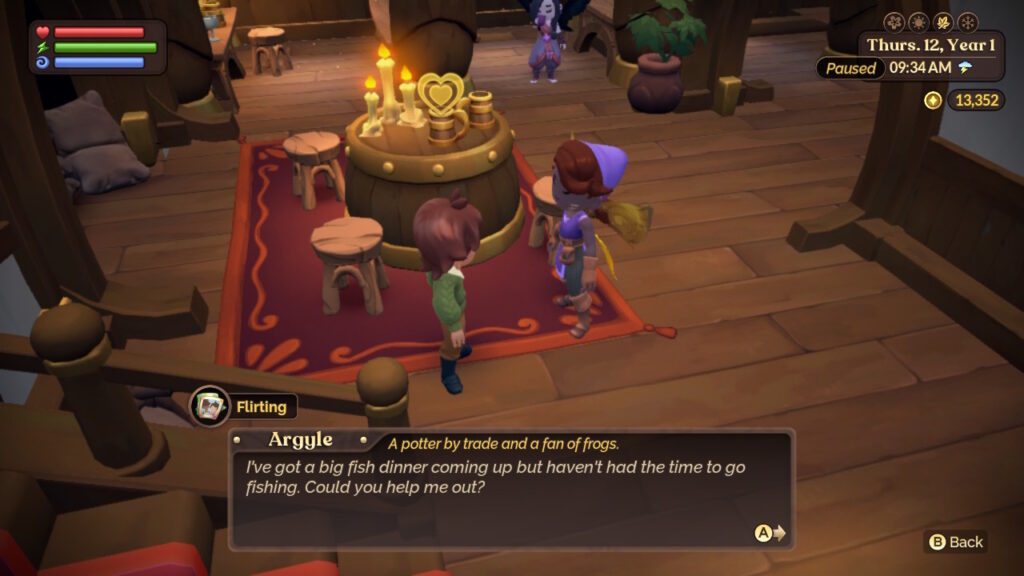
The World
Not only does all character dialogue pull from the same canned pool, there are many homes and buildings you can’t enter. I am struggling to think of another farming sim where that has been the case. Exploring the town, seeing where folks live, and visiting your favorite characters at their home is pretty standard. It makes the world feel full and engaging.
On the other hand, the map is vast and varied. You can jump (or fall) in the water, leap over cliffs and bridges (no fall damage), use springy mushrooms to jump to higher areas, explore plains and forests and beaches. It’s clear the developers care about the world a lot. It shows. And it’s beautiful.
Which is why I struggle to understand why the side characters got the shaft here. A world is a shell without inhabitants. Some of them will talk about how much they love winter, and then immediately gush about the spring blossoms. It’s like…there’s no personality there. Just carbon copies of one another, picking from a few preset personality bundles.
A few characters made an impression, though. There’s the carpenter who is in a wheelchair. The wannabe sailor who gets seasick. The wizard who looks like your average human but is a big ol’ nerd about magic. But they stand out because they have a gimmick, not a personality.
For the first few days in-game, you’ll get bounced around between the mayor, fisherman, beekeeper, and merchant guild master. They effectively work as your tutorial and I was relieved that there was no muss nor fuss in getting all your items. It meant I could dive into the world headfirst, catching bugs and fish when I didn’t feel like engaging with [insert generic NPC here].
There is a lot of stuff to do that encourages you to slow things down and explore. You can forage for items to eat or sell; you can fish and hope for a rare catch; you can catch bugs, if you’re quick with the net; and you can uncover recipes that are hidden around the world.
The item recipes are a particularly nice touch. They are hidden in buildings (the ones you can enter), on rock outcrops, in the wilderness, under bridges, and in nooks and crannies all over the map. It made me appreciate exploration as something more than just that thing you do to get from point A to point B.
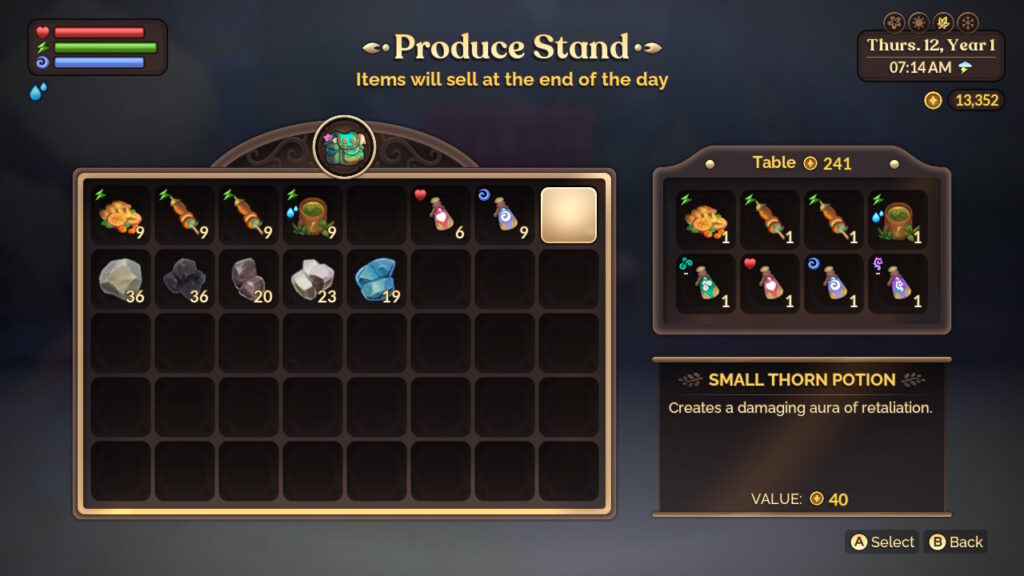
Game Mechanics
Fae Farm makes a ton of quality-of-life upgrades to farming sims. You don’t have to rotate between your basic tools (axe, pickaxe, sickle, shovel, and watering can), as the game will do so automatically depending on the item you’re engaging with.
Personally, I’ve never minded swapping tools, though many modern farming sims are moving away from this. I like the busyness of item management, but that’s definitely nostalgia taking. I would never begrudge a game for making this design decision and I think a lot of players will appreciate it. What I do really love is games where watering one crop causes the cursor to immediately lock on to the next one in the area. Fae Farm does this. Every farming sim should do this.
There were a few issues where I wanted to use one tool but the area was packed with interaction triggers and I couldn’t get it to stay on, say, the net for example. Also, interacting with the world in any way (picking up a recipe, talking to a villager) resets your equipment to the default farm tools. I hope they consider fixing this in an update. If I’m running around vanishing magical thorns with my staff, I don’t want to jump back to my sickle every time I pick up an item. Similarly, you have to put away your specialty item and jump back to the farm tools if you want to interact with things like the berry bushes (shaking them gives you huckleberries). It’s not a huge deal but it really messes up the flow of your exploration.
The game also makes you craft…everything. You can’t even plant crops without first building a garden box. I didn’t love this choice. I like being busy (and rich) in my farming sims and planting a full field right away is partly how I accomplish that. Mine and fish? Nah. I’m going to water 90 turnips every morning.
You are in control of switching between tools where players need to opt into using them, like the fishing rod, net, and magic staff. I’m sure this was a mandatory mechanic, as there is no way to know when a player is thinking about catching a bug, for example. But it works really well overall as a streamlined tool management system.
Fae Farm is predictably okay in all areas of game mechanics you would expect from a life/farming sim. The fishing mini game is kind of annoying (as is Video Game Law). Farming is what you would expect, leaning toward “better than average” thanks to the QOL considerations. Combat is meh, but clearly not a focus of the game anyway.
A few other considerations: The waypoint system is really helpful. You select a character on the map and an icon with their face on it will lead you to where they are in town. Way better than memorizing daily schedules or wasting a whole day trying to guess where someone is just to wrap up a quest.
Another gripe: the money-making system is quite limiting. You sell your wares in the town market every day on top of four display tables. The only issue is that each table has 8 item slots, meaning you can only sell 32 items per day.
There are ways in which the game makes you intentionally slow down that are appreciated, like hidden items to encourage mindful exploration. The shop system is not one of them. It’s unnecessarily hobbling and dissuades zealous players from feeling rewarded for their work and enthusiasm. You can eventually construct a merchant stall on your farm to unlock an additional 8 items, but even that doesn’t seem like enough.
Also please don’t make me hold A to accept quests. Tapping it should be more than sufficient. How else am I supposed to manic button-smash to shut people up so I can get on with my day. (I’m kidding, mostly.)

Progression & Daily Activities
Fae Farm tantalizes you with a promise of different biomes, each with a unique magical plight from cursed thorns to enchanted storms or even black pools of shadow that impede paths. The game also doesn’t explain the route you have to take to overcome each obstacle until it is good and ready. Unfortunately, I wasn’t finding that there was enough to keep me entertained until the plot unveiled the next major quest mission. I felt forced to fish (shudder) and bug-catch just to pass the time.
The world is genuinely a pleasure to explore. There’s just not enough to do. Or not enough with purpose. But, man, walking around is fun. Being able to jump anywhere (within reason) is awesome. And the little shortcuts via bouncy mushrooms ensures you aren’t doubling back too much. I know the game needs to save some locations for later down the road. I just wish there was more to do and farther to go right off the bat.
I was constantly bumping up against areas I couldn’t access yet. A cracked, glowing stone I had to destroy somehow. A blizzard I couldn’t step into without starting to take cold damage. Shadow pools that blocked my path. But the worst part was the game wasn’t going to let me start working on these issues. It wouldn’t even hint how I might. So I spent days trying to pass time so the game would deem me worthy of moving onto the next major puzzle.
A quick (obvious!) fix would be to let players sell more items at the market every day. I could totally see myself hustling to fish and forage if that was the reward. Instead, I’ll just clutter my backpack and shed if I do too much daily work.
Let me be clear: slow is fine. The new Legend of Zelda games, Persona 5, and Animal Crossing: Hew Horizon are all games that explicitly encourage players to slow down, enjoy the game, and take their time. But the trade off is the player still needs stuff to work on. And “too much” is always way better than “too little.”
I need to have stuff to do in the interim. Hustling for money and learning villager gift preferences are my favorites. But the marketplace limitations prevent the first one and Fae Farm only lets you present certain gifts to romantic prospects (no guess-and-check, no variety), and it tells you what it is right in the menu.
Just give me something, anything, that I can sink my teeth into and feel rewarded for doing so.

Dungeons & Expectations
7 in-game days in and I finally unlocked the first dungeon, Saltwater Mines! There are 3 dungeons throughout the game, with the first one being the mines. To say I was excited is an understatement. Here is a task that can occupy a ton of my time, and the rewards for diving in are high value (crafting options, tool upgrades). It took another 3 in-game days to unlock the mine’s fast travel system.
I needed 15 pieces of copper, then I could build a “seal machine,” then I could get more ore, and then I could craft seals that would unlock fast travel one floor at a time. I did all this. It was annoying, but I did it. I returned to the mines to start unlocking fast travel only to learn that the seals only work up to floor 5. Now I need a new type of seal. More digging. More foraging. More crafting. More days. It was another bottleneck in my way.
Then I realized: Fae Farm is a linear game. It’s not a sandbox game. I am not supposed to have the freedom to focus on whatever I want, nor will I be encouraged to have many things on the go at once. I have to take one step. And then the second step will open. And then I can take that step. It’s more like Animal Crossing than Stardew Valley. Eventually, I imagine, the world will open up to me. But not now. And not on my schedule.
I needed to decide if I could continue on knowing this now. It would take some drastic reframing of what I wanted to get out of the game.
I enjoyed the dungeons and resource gathering and crafting and foraging and selling for what it was: a slow, patient RPG/farming sim lovingly crafted for newbies to the genre. Opening up areas unveiled solutions to the “magical ailments” around the town, from whirlpools to storms to shadows and more. The story ticked forward and a bit of busywork was required to tide me over during the interludes. It wasn’t necessarily what I wanted, but it is most likely what some people need to welcome them into the genre.
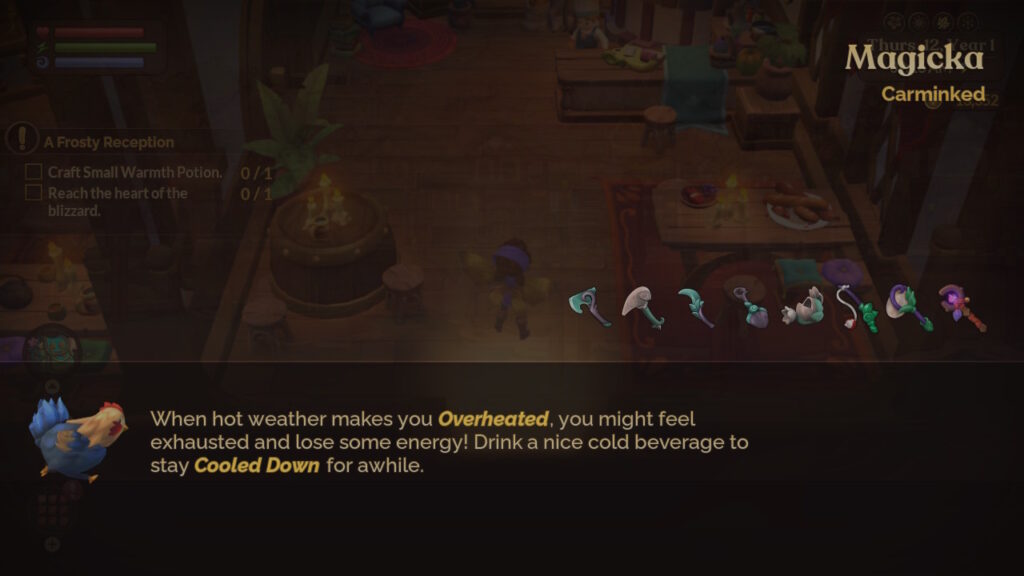
The Story: the Gist
The crux of the game is that you are lured to a magical island by a message in a bottle. Once you arrive, you can’t leave. Can’t, because the mayor guilt-trips you, but also because of the mysterious whirlpools blocking the bay. You then begin the path of extinguishing obstacle after obstacle plaguing the town. Why? It’s never really made clear. It doesn’t seem that you are trying to leave. But it also doesn’t offer any sense as to why you would stay. The characters thank you for helping out but the weight of the danger before you get there isn’t well established. What you are doing seems neither weighty nor vital.
Your first major mission is to clear the mines. Every step of the process is a tutorial quest. You get a quest to make a quick travel seal; you get a quest to gather ore and upgrade your tools; you get a quest to reach floor 25 (the bottom). The game doesn’t trust you to want to do these things on your own. And that’s a problem. A good game hands you a premise, and then lets you make the next move. And the next one. And the one after that. If the only thing driving us forward is the tutorial, then the game has forgotten a critical element to storytelling: the heart.
After the first dungeon is when the “real” story seems to begin. You will meet the Wisp Mother, a deity-type figure for the island. She will recruit your help to restore things to their former glory, though the risk of refusing her is unclear. Has the town been suffering until you got here? Most of their complaints are about aesthetics and convenience. The thorns and smog are unsightly and in the way of the scenic veiws. If they don’t care, why should I? I just want to breed flowers. I don’t even know you people.
In order to advance the story, you will be given collection and crafting quests from these sorts of larger-than life-guardians and deities. They include up to 5 mini-quests and require you to gather, fish, craft, and so on. It’s a lot of busywork and won’t leave the player much time to explore the parts of the game they like best. It also feels like a distraction. It works to hide the fact that the town feels lifeless if you really stop to look at it. The storytelling is quests. The festivals are quests. Dating is more quests. But where are the moments that ground and drive you? Where are the cutscenes giving you deeper insights into the way the town worked before you got here, and what your touch has done to change things?
I won’t give too much away but, yes, there are other dungeons that take you farther and farther away from your farm. The gameplay quickly becomes chaos. You need to forage in order to make a potion; you need the potion to enter the dungeon; in the dungeon, you need ore and gems to maintain progress momentum, but you need to stop what you are doing to go craft the door seals; every so often, you need to drop everything to go back to the forage-to-potion pipeline so that you can stay in the dungeon longer. I call this a “jagged linear” story, where you are technically following a linear path but have to bounce forward and back and forward and back to get everything you need. Worst of both worlds. Your farm and the village you started in quickly becomes forgotten. You don’t have time to pet your animals, much less try to find a romantic partner or do job quests.
The problem with questing-based farming sims that take you to new areas to advance the story is exactly what I just outlined above. You get so carried away pulling on story threads that the foundation of the game gets lost. You might as well not have a farm or homebase. It would certainly be easier.
Nothing feels meaningful, homey, or grounded. I don’t know where I’m going and the journey itself is cumbersome. I’m untethered, floating—and the sky is starting to storm.

Technical Issues
I actually had a few technical issues. I was playing Fae Farm on Nintendo Switch, so these might not carry over to Steam or other consoles.
- Button unresponsiveness, particularly when you try to switch commands while standing in front of the target. Ex. I would try to go from petting to brushing my animal without moving my avatar and it wouldn’t register.
- Spelling error. I generally understand when something slips through but when you pay so much money for a new game you expect it to be polished.
- The Animal Lure didn’t work at all for me. This was a big deal because the animals would wander through my crops and block me from watering and harvesting them. The game would default to the pet/brush often. Very frustrating.
- The auto-select for tools sometimes got in the way. Ex. I would accidentally devastate my animal feed grass with the sickle instead of petting the livestock.
- The game crashed once for me. This could be my Switch getting old but it tends to handle less demanding games like farming sims just fine.
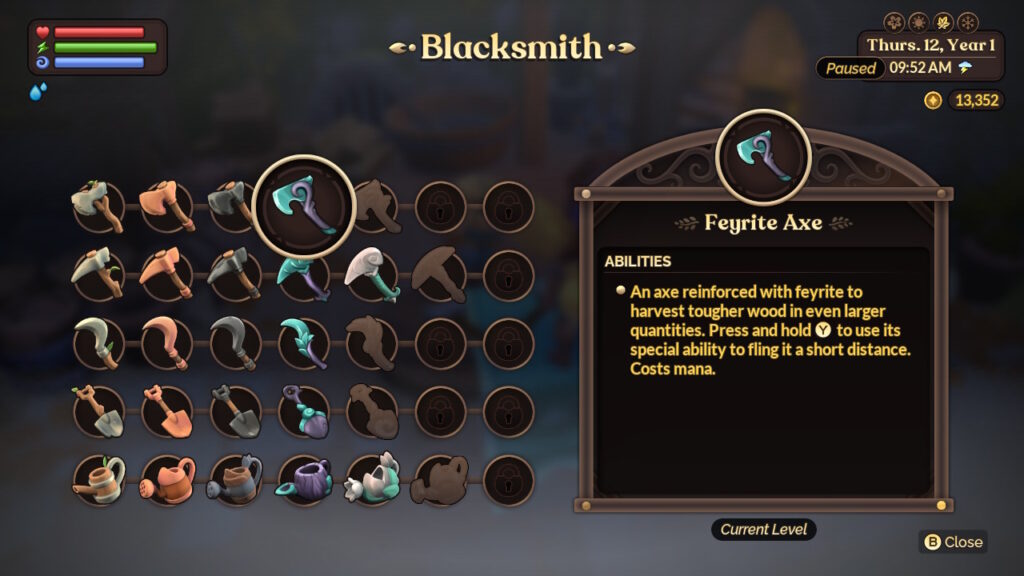
In Summary
Fae Farm is a charming, quirky adventure RPG-lite and farming/life simulation game that does a lot of little things right. The world is meticulously crafted and the core of the story is compelling. It’s a great jumping off point for players unfamiliar with adventure farming sims, as it will patiently walk you through all the mechanics and tropes that more experienced players may take for granted. For those looking for something deeper, more moving, or complex, they may not find it here. Generic NPCs and on-rails story progression could leave you feeling dissatisfied. The game would have benefited from building out social links and deeper emotional ties to the story and world. These tidbits may come with future updates, but I would recommend uncertain players wait and see how that turns out before they buy.
If I could wave my magic wand and fix only one thing about the game, it would be this: Make the side characters more deep, more complex, more realized. Don’t let them be placeholders, let them each have their own light. And let it be bright. Let it guide the game. You’ll find players don’t mind not having much to do, so long as they have someone worth talking to.
The Verdict
If you are looking for a casual action RPG/life sim, you will probably enjoy Fae Farm. If you are way, way deep into farming sims (like me) and looking for an experience that takes things to the next level, you will probably be disappointed.
If you are in camp two, wait for a sale. The game is very okay! You won’t regret spending a couple bucks on it and tinkering in the world for a bit. Paying full price on release day and knocking other games out of the way to test it out has me feeling a bit let down.
Ideally, interested but hesitant parties should follow @FaeFarm on social media and watch for a DLC/update roadmap. The official Nintendo product page says: “between December 2023 and June 2024, two waves of free additional content will be released to expand your horizons.” It could very well be that these updates are what the game needs to feel more fleshed out where it counts.
Who Fae Farm is for:
- You’re new to farming sims (seriously, it’s great at showing you the ropes!)
- Animal Crossing fans who don’t mind a farming sim-lite
- Current Harvest Moon / Story of Seasons fans not looking to reinvent the wheel
Who Fae Farm is not for:
- Farming sim fanatics looking for the next big thing
- Those who want in-depth, believable social relationships in their simulation games
- Gamers expecting more of a free roam/sandbox experience
What did you think of the game? Let me know on social media (@cozygamereview everywhere) or in the comments below.
Stay cozy, gamers!
